Reducing Feature Size in Laser Implantation Texturing †
Abstract
:1. Introduction
2. Methodologies
2.1. Experimental Setup
2.2. Materials
2.3. Powder Particles
2.4. Analysis Tools
2.5. Methods
3. Results and Discussion
3.1. TiB2 Implantations
3.2. WC Implantations
3.3. Dispersion of WC Particles
3.4. Hardness WC Implants
4. Conclusions
- a laser spot intensity of 500 kW/cm2 creates dome-shaped implants,
- a laser spot intensity above 500 kW/cm2 yields ring-shaped implants,
- decreasing the laser pulse power decreases the dimensions of the implants,
- increasing the laser pulse time increases the dimensions of the implants,
- and implantation diameters as small as 64 m and heights as small as 1 m could be produced.
Author Contributions
Funding
Data Availability Statement
Conflicts of Interest
Abbreviations
| LITex | Laser implantation texturing |
| SBT | Shot blast texturing |
| EDT | Electron discharge texturing |
| ECD | Electro-chemical deposition |
| EBT | Electron beam texturing |
| LT | Laser texturing |
| EDX | Energy dispersive X-Ray |
| HAZ | Heat-effected zone |
| LIZ | Laser-implanted zone |
| SEM | Scanning electron microscopy |
References
- Hideo, K. Mechanism of Roughness Profile Transfer in Skin-pass Rolling of Thin Steel Strip. In Proceedings of the Engineering, Materials Science 2018, Darmstadt, Germany, 26–28 September 2018. [Google Scholar]
- Simão, J.; Aspinwall, D. Hard chromium plating of EDT mill work rolls. J. Mater. Process. Technol. 1999, 92–93, 281–287. [Google Scholar] [CrossRef]
- Gorbunov, A.V.; Belov, V.K.; Begletsov, D.O. Texturing of rollers for the production of auto-industry sheet. Steel Transl. 2009, 39, 696. [Google Scholar] [CrossRef]
- Thomas, J.; Morgan, B. A review of the development of the use of electro discharge textured and hard chromium plated work rolls within British Steel Strip Products. In Proceedings of the Rolls 2000 Conference; Institute of Materials: Birmingham, UK, 1996; pp. 176–185. [Google Scholar]
- Simao, J.; Aspinwall, D.; Wieltsch, M. Electrical Discharge Texturising of Mill Rolls and the Effect of Hard Chromium Plating/TiN Coating on Roll Surface Topography and Integrity. VDI Berichte 1998, 1405, 359–368. [Google Scholar]
- Kleinz, H.; Urlberger, H. Hard-chromed work rolls for the production of cold-rolled sheet. Metall. Plant Tech 1992, 6, 76–82. [Google Scholar]
- Gaspard, C.; Bolt, H.; Bertrandie, J.; Vanhumbeeck, J.; Evans, G.; Bixquert, F.; Dietsch, H.; Debrabandere, D.; Batazzi, D.; Uijtdebroeks, H.; et al. Substitution of Chrome Plating for the Rolls of Skin-Pass Mill (CRFREEROLLS); Directorate-General for Research and Innovation (European Commission): Brussels, Belgium, 2016. [Google Scholar]
- Hilgenberg, K.; Behler, K.; Steinhoff, K. Localized dispersing of ceramic particles in tool steel surfaces by pulsed laser radiation. Appl. Surf. Sci. 2014, 305, 575–580. [Google Scholar] [CrossRef]
- Li, N.; Liu, W.; Wang, Y.; Zhao, Z.; Yan, T.; Zhang, G.; Xiong, H. Laser Additive Manufacturing on Metal Matrix Composites: A Review. Chin. J. Mech. Eng. 2021, 34, 38. [Google Scholar] [CrossRef]
- Tseng, W.; Aoh, J. Simulation study on laser cladding on preplaced powder layer with a tailored laser heat source. Opt. Laser Technol. 2013, 48, 141–152. [Google Scholar] [CrossRef]
- Hilgenberg, K.; Steinhoff, K. Texturing of skin-pass rolls by pulsed laser dispersing. J. Mater. Process. Technol. 2015, 225, 84–92. [Google Scholar] [CrossRef]
- Spranger, F.; de Oliveira Lopes, M.; Schirdewahn, S.; Degner, J.; Merklein, M.; Hilgenberg, K. Microstructural evolution and geometrical properties of TiB2 metal matrix composite protrusions on hot work tool steel surfaces manufactured by laser implantation. Int. J. Adv. Manuf. Technol. 2020, 106, 481–501. [Google Scholar] [CrossRef]
- Schirdewahn, S.; Carstensen, N.; Hilgenberg, K.; Merklein, M. Laser Implantation of Titanium-Based Particles into Hot Stamping Tools for Improving the Tribological Performance During Hot Sheet Metal Forming. In Proceedings of the 14th International Conference on the Technology of Plasticity—Current Trends in the Technology of Plasticity, Napoule, France, 24–29 September 2023; pp. 301–309. [Google Scholar] [CrossRef]
- Uddeholm. Uddeholm Rigor. Available online: https://www.uddeholm.com/app/uploads/sites/49/2017/09/Tech-Uddeholm-Rigor-EN.pdf (accessed on 5 June 2024).
- Kron, P. Verschleissschutz Durch Laseroberflächenbehandlung von Kalt- und Warmarbeitsstählen. Ph.D. Thesis, RWTH Aachen University, Aachen, Germany, 1996. [Google Scholar]
- Sigma-Aldrich. Product Specification Tungsten Carbide. Available online: https://www.sigmaaldrich.com/specification-sheets/340/429/241881-BULK_______ALDRICH__.pdf (accessed on 3 April 2024).
- Lengauer, W. Transition Metal Carbides, Nitrides, and Carbonitrides. In Handbook of Ceramic Hard Materials; John Wiley & Sons, Inc.: Hoboken, NJ, USA, 2000. [Google Scholar] [CrossRef]
- Munro, R. Material Properties of Titanium Diboride. J. Res. Natl. Inst. Stand. Technol. 2000, 105, 709. [Google Scholar] [CrossRef] [PubMed]
- Mowital, K. Mowital B Technical Data Sheet. Available online: https://www.mowital.com/fileadmin/Dateien/TDS_Mowital_R__B__BA__G__SB/TDS_Mowital_B-EN.pdf (accessed on 5 March 2024).
- Evans, D.; Wennerström, H. The Colloidal Domain: Where Physics, Chemistry, Biology, and Technology Meet; VCH Publishers: Weinheim, Germany, 1994. [Google Scholar]
- Hilgenberg, K.; Spranger, F.; Bachmann, M. Localized laser dispersing of titanium-di-boride with pulsed fiber laser. In Proceedings of the ICALEO 2017: 36th International Congress on Applications of Lasers & Electro-Optics, Atlanta, GA, USA, 22–26 October 2017. [Google Scholar] [CrossRef]
- Hibiya, T.; Ozawa, S. Marangoni Flow and Surface Tension of High Temperature Melts. In High-Temperature Measurements of Materials; Fukuyama, H., Waseda, Y., Eds.; Springer: Berlin/Heidelberg, Germany, 2009; pp. 39–59. [Google Scholar] [CrossRef]
- Le, T.N.; Lo, Y.L. Effects of sulfur concentration and Marangoni convection on melt-pool formation in transition mode of selective laser melting process. Mater. Des. 2019, 179, 107866. [Google Scholar] [CrossRef]
- Spranger, F.; Hilgenberg, K. Dispersion behavior of TiB2 particles in AISI D2 tool steel surfaces during pulsed laser dispersing and their influence on material properties. Appl. Surf. Sci. 2018, 467–468, 493–504. [Google Scholar] [CrossRef]
- Schirdewahn, S.; Spranger, F.; Hilgenberg, K.; Merklein, M. Localized dispersing of TiB2 and TiN particles via pulsed laser radiation for improving the tribological performance of hot stamping tools. Procedia CIRP 2020, 94, 901–904. [Google Scholar] [CrossRef]
- Spranger, F.; Hilgenberg, K. Laser Implantation: An Innovative Technique for Surface Texturing. PhotonicsViews 2019, 16, 38–41. [Google Scholar] [CrossRef]
- Spranger, F.; Schirdewahn, S.; de Oliveira Lopes, M.; Merklein, M.; Hilgenberg, K. Investigations on TaC Localized Dispersed X38CrMoV5-3 Surfaces with Regard to the Manufacturing of Wear Resistant Protruded Surface Textures. Lasers Manuf. Mater. Process. 2020, 7, 38–58. [Google Scholar] [CrossRef]
- Vilar, R.; Colaço, R.; Almeida, A. Laser Surface Treatment of Tool Steels. Opt. Quantum Electron. 1995, 27, 1273–1289. [Google Scholar] [CrossRef]
- Peng, Y.; Zhang, W.; Li, T.; Zhang, M.; Liu, B.; Liu, Y.; Wang, L.; Hu, S. Effect of WC content on microstructures and mechanical properties of FeCoCrNi high-entropy alloy/WC composite coatings by plasma cladding. Surf. Coat. Technol. 2020, 385, 125326. [Google Scholar] [CrossRef]
- Huber, F.; Bischof, C.; Hentschel, O.; Heberle, J.; Zettl, J.; Nagulin, K.Y.; Schmidt, M. Laser beam melting and heat-treatment of 1.2343 (AISI H11) tool steel –microstructure and mechanical properties. Mater. Sci. Eng. A 2019, 742, 109–115. [Google Scholar] [CrossRef]





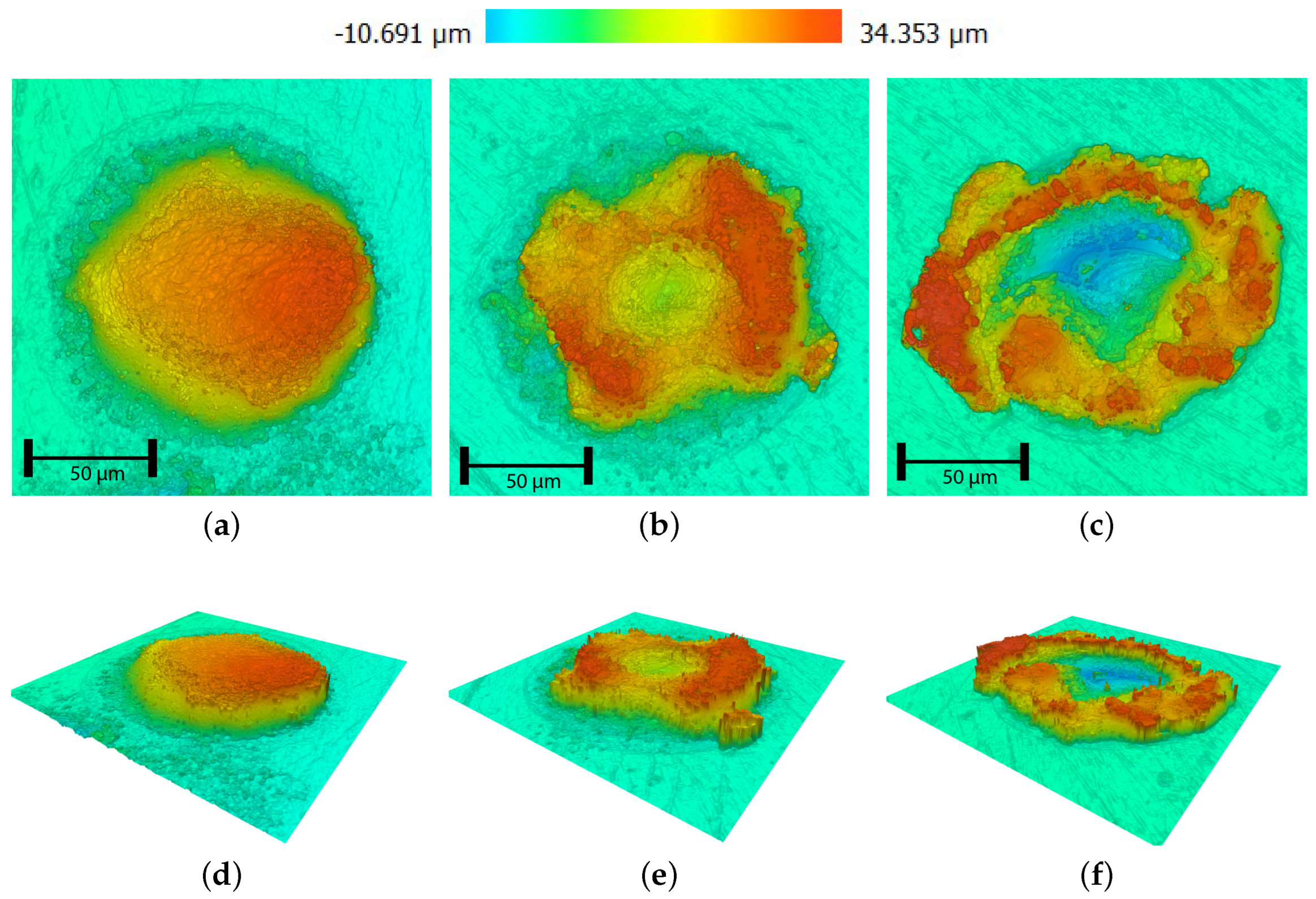
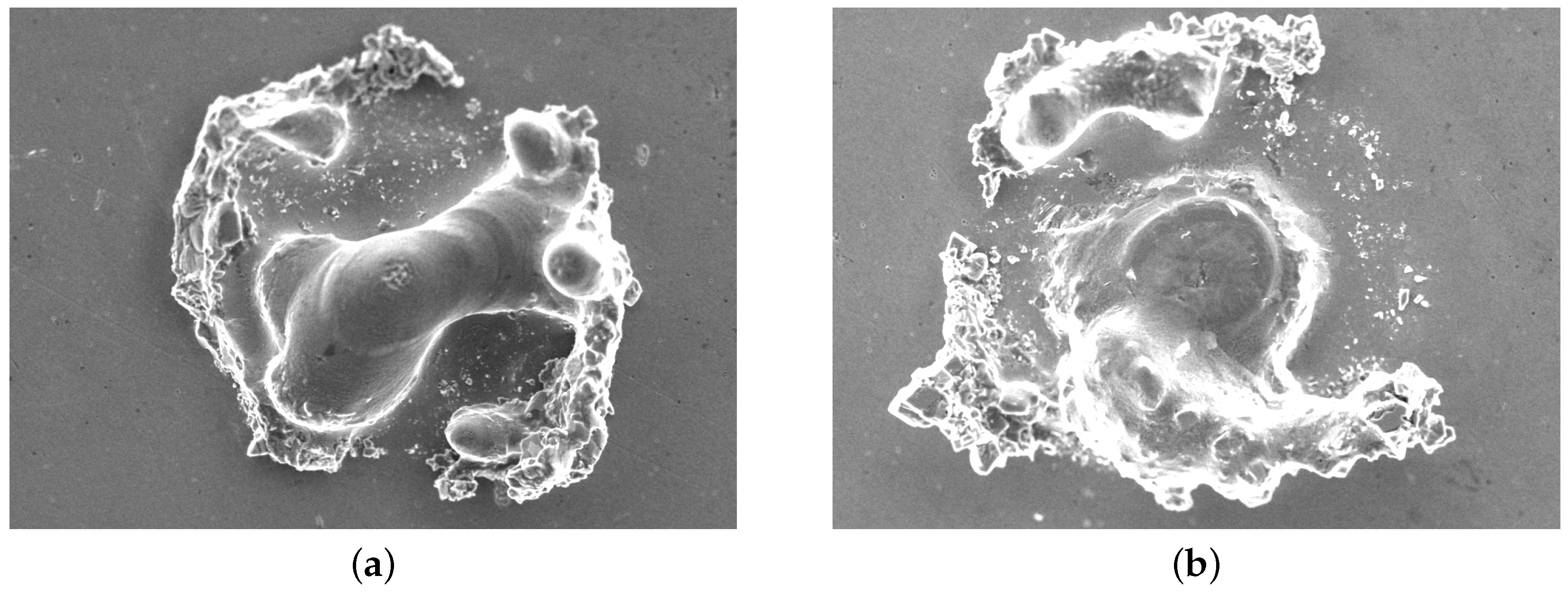
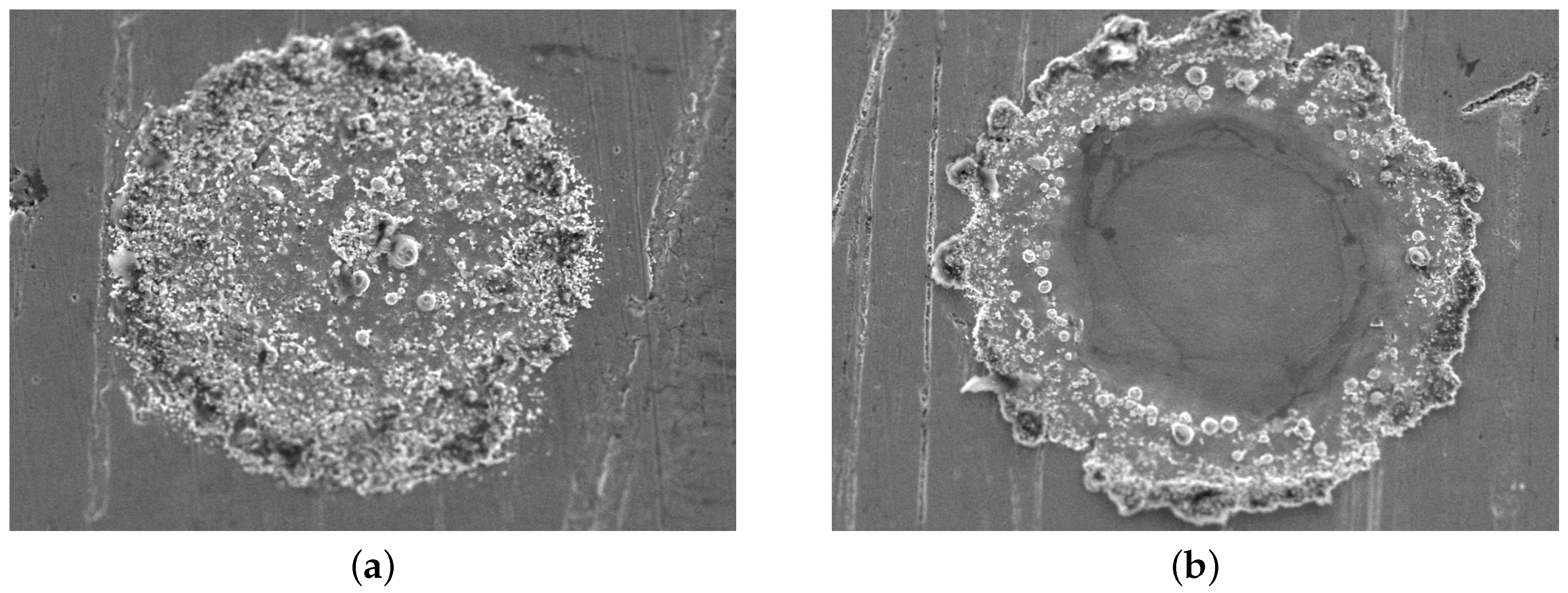
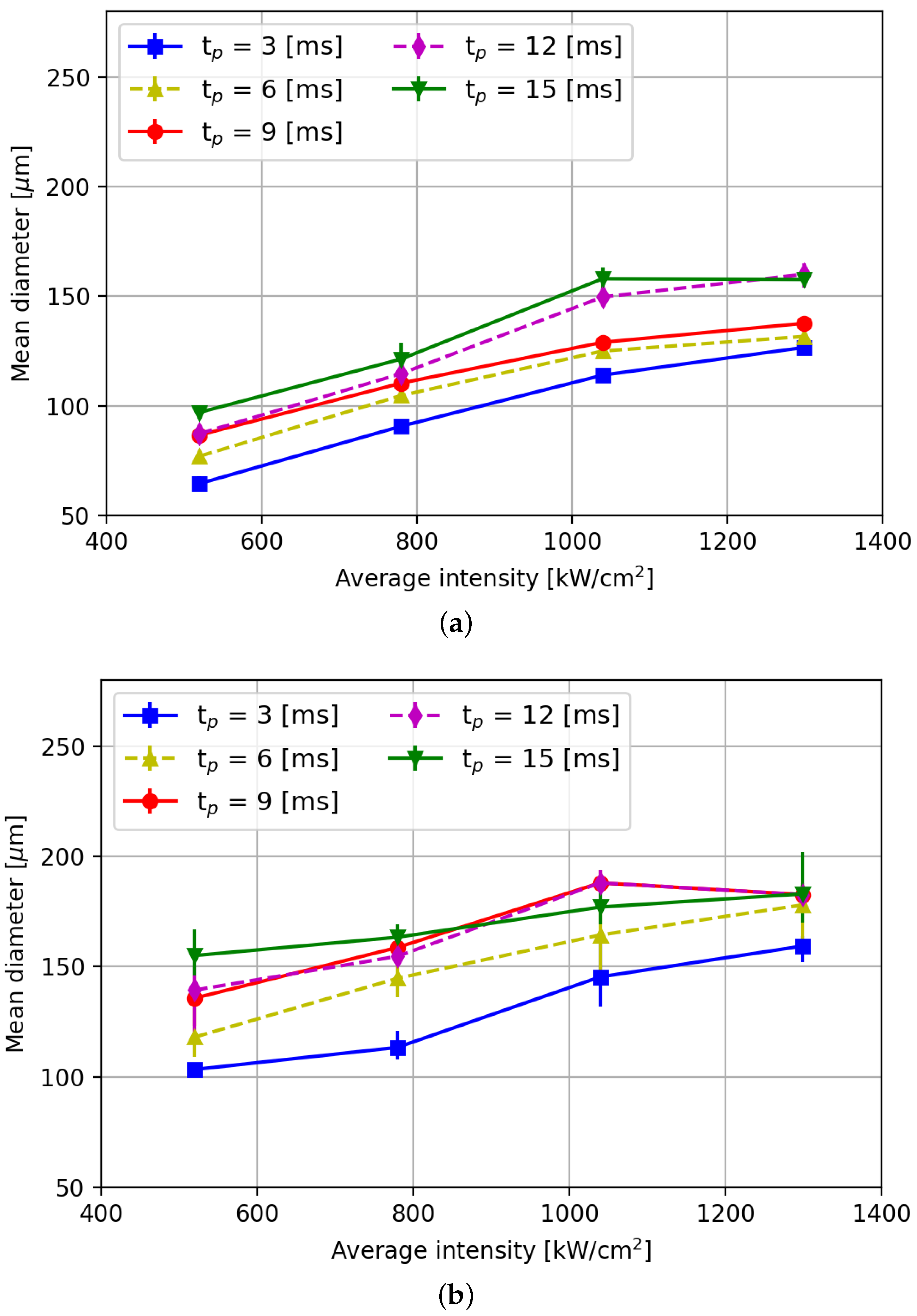
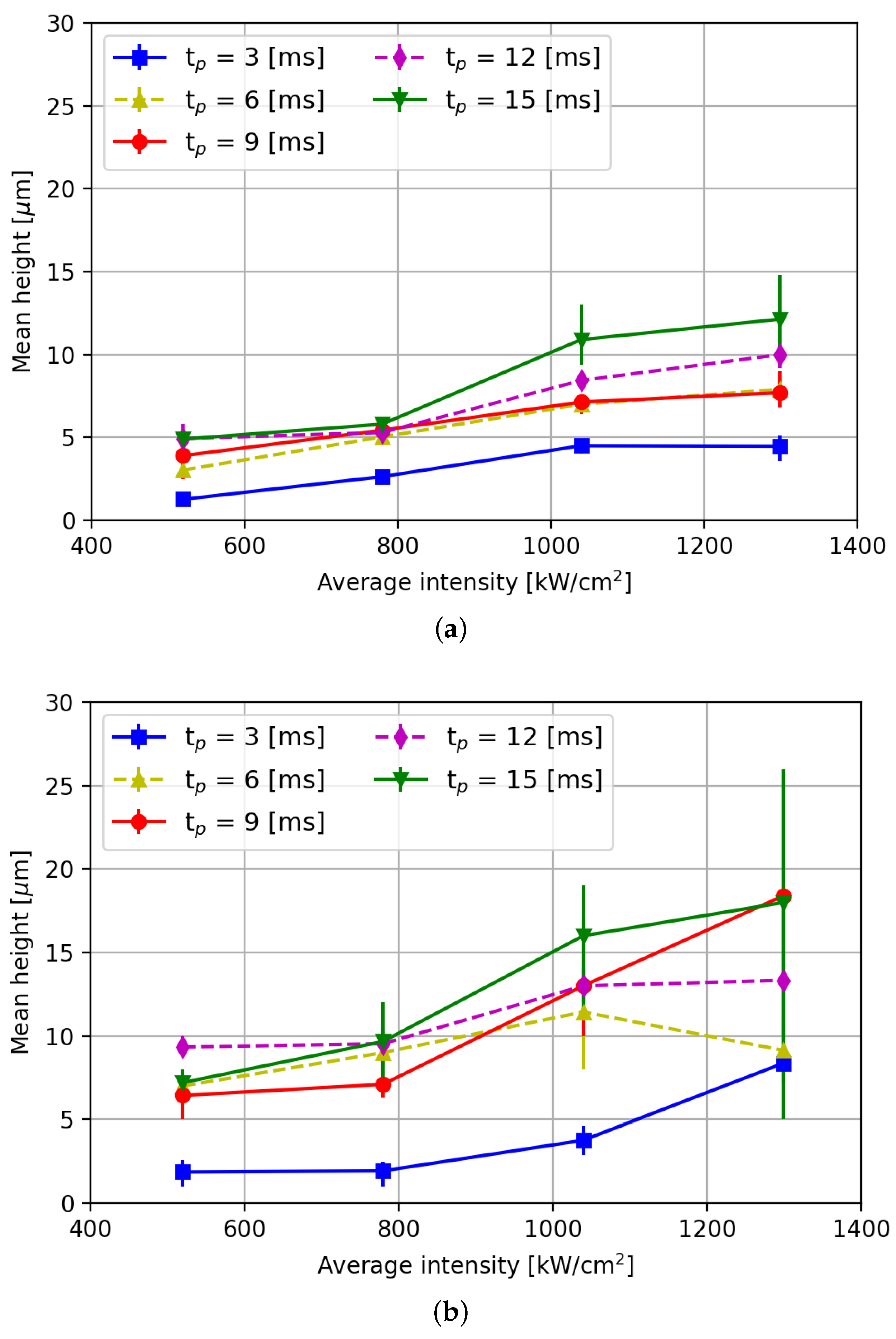


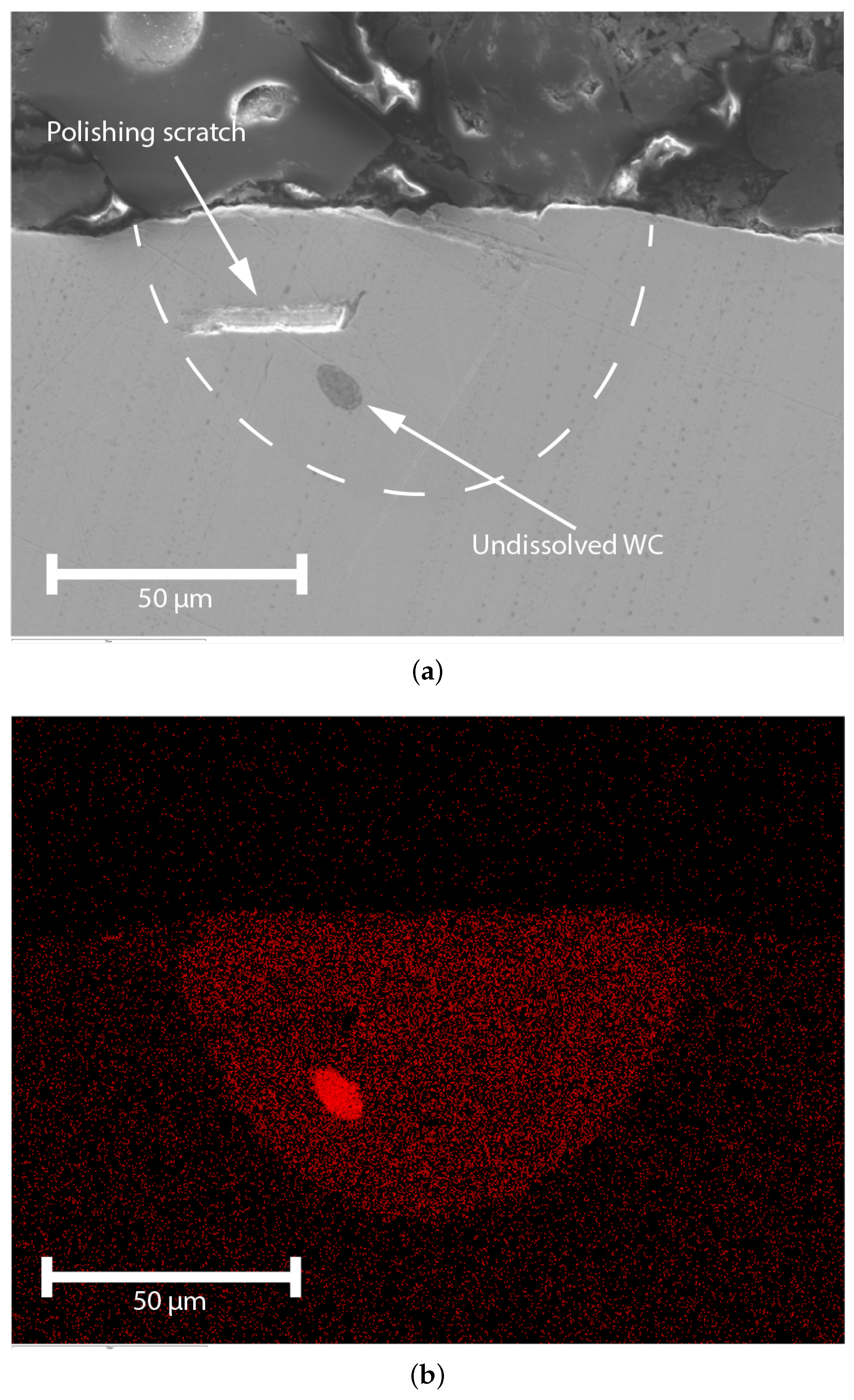
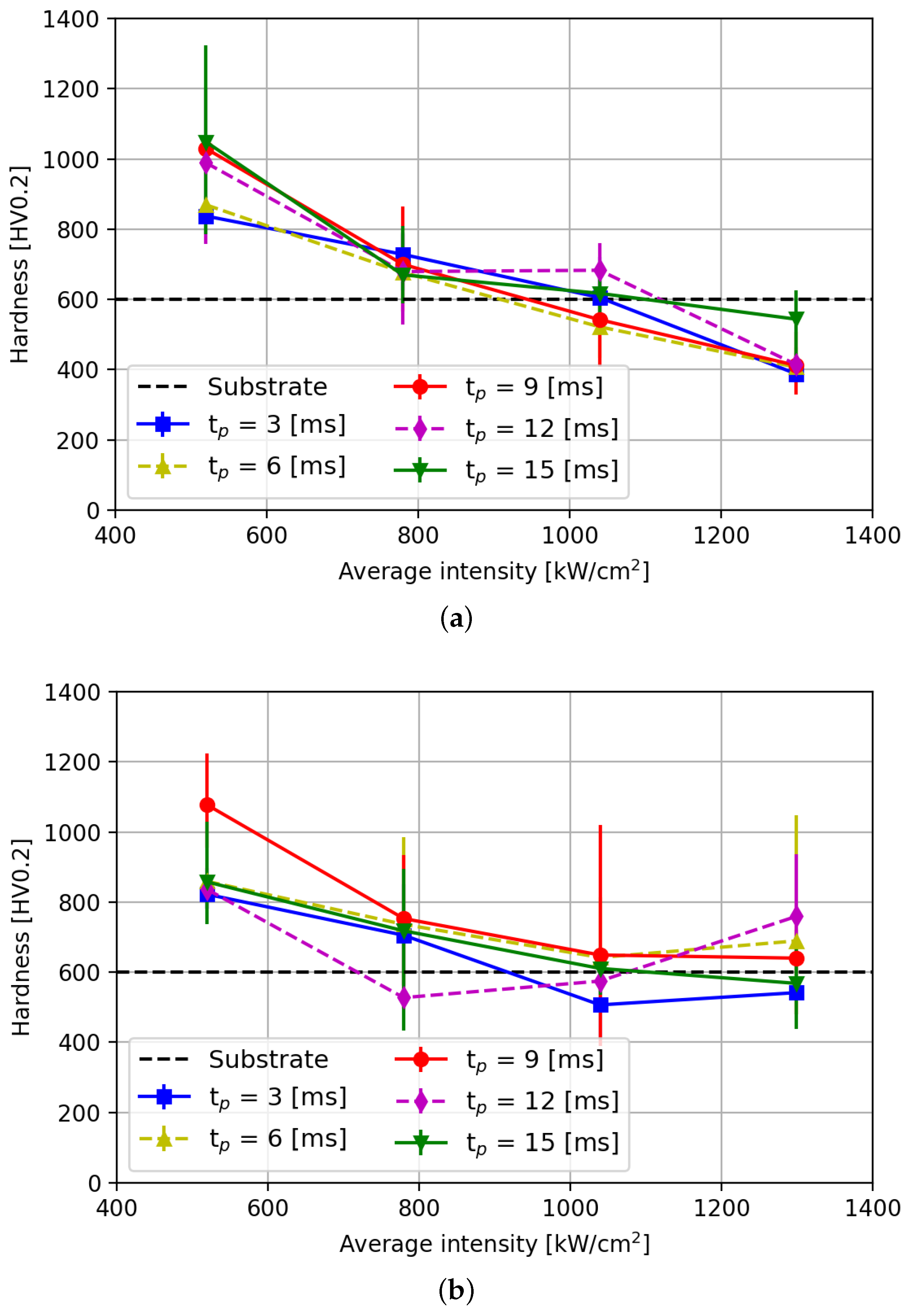
| C | Si | Mn | Cr | Mo | V |
|---|---|---|---|---|---|
| 1% | 0.3% | 0.16% | 5.3% | 1.1% | 0.2% |
| X100CrMoV5 | |
|---|---|
| Density [kg/m3] | 7860 |
| Melting point [°C] | 1424 |
| Hardness [Hv] | 600 |
| WC | TiB2 | Mowital 30H | |
|---|---|---|---|
| Specified particle size d50 [m] | 2 | 10 | - |
| Measured d50 [m] | 1.15 | 4.23 | - |
| Density [kg/m3] | 1560 | 4520 | 1080 |
| Hardness [Hv] | 2200 | 3400 | - |
| Melting point [°C] | 2785 | 3230 | 165 |
| WC | TiB2 | |
|---|---|---|
| Layer height [m] | 50, 75 | 50, 75 |
| Laser pulse duration [ms] | 3–20 | 3–20 |
| Laser pulse power [W] | 20–50 | 20–50 |
| Laser spot diameter [m] | 70 | 70 |
| Average laser intensity [kW/cm2] | 520–1300 | 520–1300 |
| Element | Fe | W | C | Cr | Mo | Si | V | Ca |
|---|---|---|---|---|---|---|---|---|
| wt.% | 75.6 | 9.2 | 9.1 | 4.6 | 0.9 | 0.3 | 0.2 | 0.1 |
Disclaimer/Publisher’s Note: The statements, opinions and data contained in all publications are solely those of the individual author(s) and contributor(s) and not of MDPI and/or the editor(s). MDPI and/or the editor(s) disclaim responsibility for any injury to people or property resulting from any ideas, methods, instructions or products referred to in the content. |
© 2024 by the authors. Licensee MDPI, Basel, Switzerland. This article is an open access article distributed under the terms and conditions of the Creative Commons Attribution (CC BY) license (https://creativecommons.org/licenses/by/4.0/).
Share and Cite
Ettema, B.; Matthews, D.; Römer, G.-W. Reducing Feature Size in Laser Implantation Texturing. Micromachines 2024, 15, 958. https://doi.org/10.3390/mi15080958
Ettema B, Matthews D, Römer G-W. Reducing Feature Size in Laser Implantation Texturing. Micromachines. 2024; 15(8):958. https://doi.org/10.3390/mi15080958
Chicago/Turabian StyleEttema, Bart, Dave Matthews, and Gert-Willem Römer. 2024. "Reducing Feature Size in Laser Implantation Texturing" Micromachines 15, no. 8: 958. https://doi.org/10.3390/mi15080958
APA StyleEttema, B., Matthews, D., & Römer, G.-W. (2024). Reducing Feature Size in Laser Implantation Texturing. Micromachines, 15(8), 958. https://doi.org/10.3390/mi15080958





